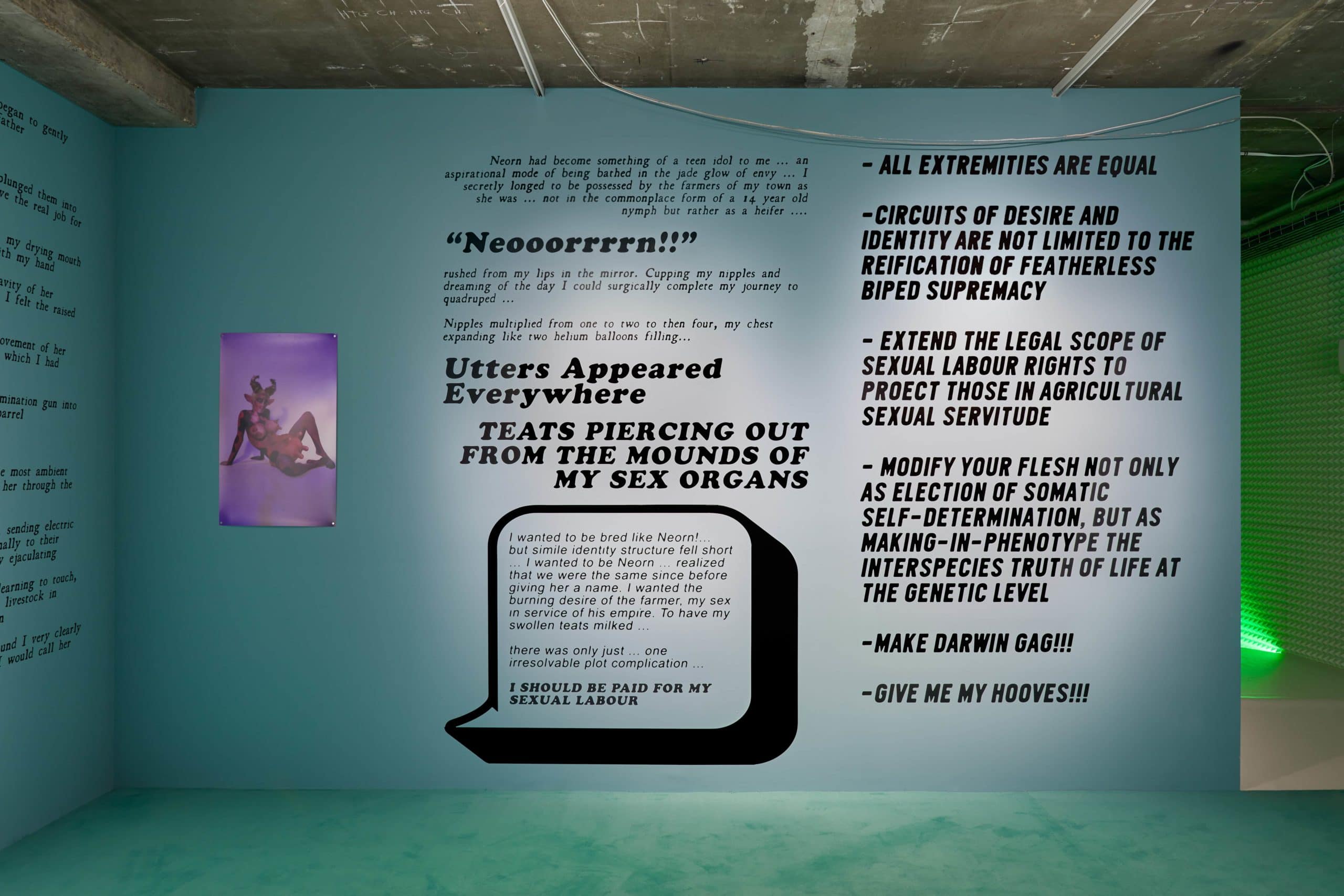
Enter through a repurposed car park and end up inside an ice cap. A white room lit so bright your eyes never quite adjust. Faux powder snow at the foot of a towering painting: an expressionist flurry in blue.
With its Rorschach symmetry, it could be a brain scan, orange and yellow patches denoting more active areas. But abstraction is offset by figurativism: Donna Huanca’s ‘Espejo Espiral’ (2019) depicts the back of two women’s heads. Their long braids are picked out with more careful, considered brushstrokes that evoke the meditative state a little girl might enter when braiding her friend’s hair. Birds chitter on the sound system somewhere between tranquil and alarming, with loud crackles like firecrackers thrown at your feet.
Birds chitter on the sound system somewhere between tranquil and alarming
Transformer: A Rebirth of Wonder’s next room is dark and people are sitting cross-legged inside a kaleidoscope formed by screens and mirrors, shifting geometric patterns. A droning electronic soundscape to match the drone of traffic on cloverleaf interchanges. Spaghetti motorways at night glowing the colour of something preservative; amber; formaldehyde.
Doug Aitken’s ‘New Era’ (2018) moves from motorways to Motorola and to the company’s engineer Martin Cooper, who invented the mobile phone in 1973. Aitken humanises this technological leap, giving us Cooper in his own words, only to then dehumanise Cooper’s voice by running it on loop, until ‘I made a phone call’ sounds banal, bathetic, robotic, miraculous. Until ‘I made a phone call’ sounds like let there be light.
Spaghetti motorways at night glowing the colour of something preservative; amber; formaldehyde
Step out of the kaleidoscope and into a room with blue striplights on the stairs. Camouflage netting on the walls. Trap music snapping on an empty, spotlit dance floor. The feeling we’ve been here before: a place where all the codifiers and mediators of fun mean it’s hard to have any. On TV screens, we roam through a CGI version of the place we’re in, which is a nightclub called Temple no a subterranean Brutalist car park near Temple tube stop no a multiplication of the two.
Lawrence Lek’s ‘Temple OST’ (2019) provokes in me two quite specific experiences: one is having died in a video game that allows you to watch the other players continue to fight it out; the other is sitting on blue stairs in an emptying nightclub where the staff are giving you looks like why are you here. Both experiences involve missing out: the failure of having died, while everyone else is still playing; the FOMO that keeps you from going home. Virtual and material worlds fuse in a premonitory déjà visité. I will have been here.
Camouflage netting on the walls. Trap music snapping on an empty, spotlit dance floor.
Leave Lek’s Temple and encounter Chen Wei’s ‘Pillar of Broken’ (2015), a lightbox photograph of what could be a futuristic fuel cell, but is actually a mirrored column that has toppled and cracked: at once a symbol of utopian promise and its dissolution.
Chen’s image seems emblematic of a wider project within the exhibition, which takes its name from Lawrence Ferlinghetti’s poem ’I Am Waiting’, whose speaker longs for dramatic social change — ‘a rebirth of wonder’. The poem is a hopeful prophecy that also feels mired by its repetitive ‘waiting’, with the speaker listing the destructive forces of culture, while taking no action to eradicate them. Like Ferlinghetti’s poem, Chen’s ‘Pillar of Broken’ is caught between renaissance and decline.
At once a symbol of utopian promise and its dissolution
For Transformer, decline is hypersaturation, information overload. Rebirth requires carving new connective paths through a noise of signs and symbols. ‘Will you find beauty in this sea of data?’ asks the voiceover in one of Korakrit Arunanondchai’s video works.
Arunanondchai’s films combine subjects worlds apart: from his grandmother putting on her slippers to snake deities writhing on post-apocalyptic plains. Elsewhere, we find Victoria Sin, in Sailor Moon-inspired latex, guiding us through the chakras. Meanwhile, Jenn Nkiru’s hypnotic videos mash up the Nation of Islam with James Baldwin, Chance the Rapper and Sun Ra. All of these works present highly idiosyncratic, mediated worlds, with a poetics of saturation, combining signs as personal as they are political. But they are easily parsable. We take our cues from music videos, drag, and YouTube supercuts respectively, barely blinking. These are ludic works with their hats in the ring.
Meanwhile, Jenn Nkiru’s hypnotic videos mash up the Nation of Islam with James Baldwin, Chance the Rapper and Sun Ra.
Jean Baudrillard gives us the example of Disneyland to illustrate how we can no longer differentiate between reality and a simulacrum: Disneyland’s obvious fictitiousness and childishness coerces us into believing that the rest of the world isn’t governed by similar fictions and childish ideologies.
Transformer goes the other way. By examining the shortcomings in culture, and braiding together reality with the symbols and signs that also construct it, we emerge from the exhibition’s subterranean world(s) into one that seems a little more hopeful. A world in which we might find beauty in a sea of data. In which we might shape better fictions and find new connections to affect change. Exit the theme-park-car-park. Enter a world in which Lawrence Ferlinghetti is still waiting.


